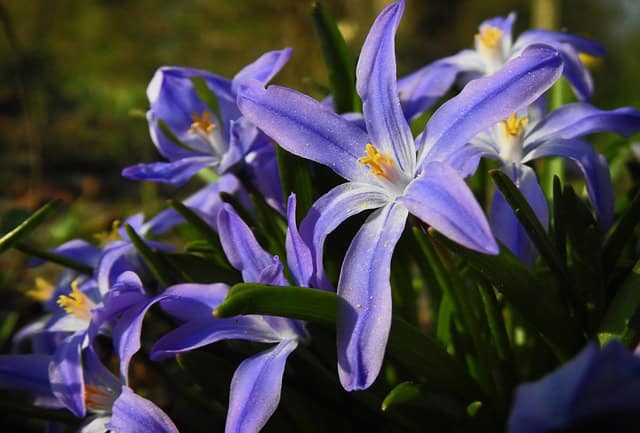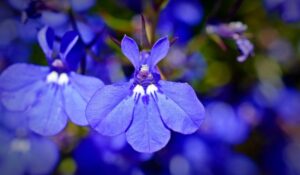As winter descends, many gardeners may find themselves yearning for color amidst the gray landscape. Zone 7, with its milder winters than many regions, allows for a unique selection of winter flowers that can bring vibrant hues and life to your garden, even in the depths of winter.
Crocus

Crocus bulbs are among the heralds of spring, often peeking through the late winter snow in Zone 7. These delightful flowers are notable for their hardiness and vibrant colors, varying from purples and yellows to whites and even striped patterns. What makes Crocus particularly suited for winter in this zone is their ability to thrive in a range of conditions — they flourish in well-drained soil with full sun to partial shade.
Planting Crocus bulbs in the fall ensures an early display, as these flowers often bloom as early as late February or March. They can be naturalized in lawns or used in borders for a stunning effect. Gardeners often appreciate the fact that once planted, Crocus bulbs can multiply and spread over the years, creating a beautiful carpet of color. Additionally, they are relatively low-maintenance, making them an excellent choice for both novice and experienced gardeners.
One interesting fact about Crocus is that some species, like the saffron crocus (Crocus sativus), not only provide stunning blooms but also produce saffron, one of the most expensive spices in the world, harvested from the flower stigmas. This diversity in function and appearance makes Crocus a must-have in any Zone 7 winter flower garden.
Cyclamen
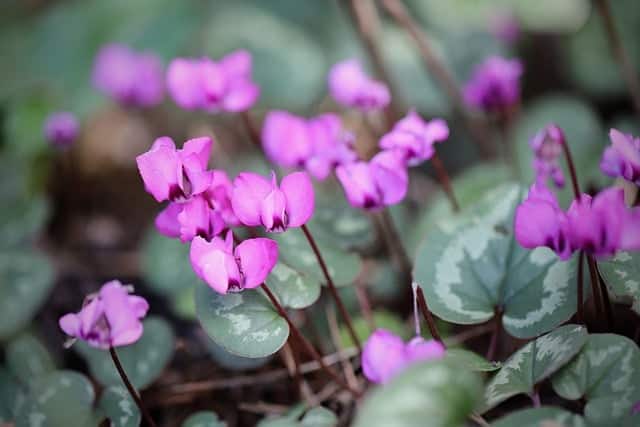
Cyclamen adds a touch of elegance to winter landscapes with its uniquely shaped leaves and exquisite blooms that often feature vibrant hues of pink, red, or white. This perennial plant thrives in cooler temperatures and can withstand frost, making it an ideal choice for Zone 7 gardens. Known for their charming heart-shaped leaves, Cyclamen not only offer winter blooms but also attractive foliage that persists throughout the year.
What differentiates Cyclamen from many other winter flowers is their growing habits. These native Mediterranean plants prefer a well-draining, leaf-rich soil and thrive in partially shaded areas. This makes them perfect for shaded garden corners or beneath tall trees, where they can create a stunning display of color.
The flowers themselves emerge on long stems that rise above the leaves, bringing an architectural beauty to any garden arrangement. To extend their bloom time, gardeners can plant various Cyclamen species with staggered blooming seasons. Plus, their low-growing habit ensures they complement taller plants beautifully. The winter fragrance of Cyclamen can fill your garden with a soft, pleasant scent, enhancing the overall experience for anyone who passes by.
Wake Robin
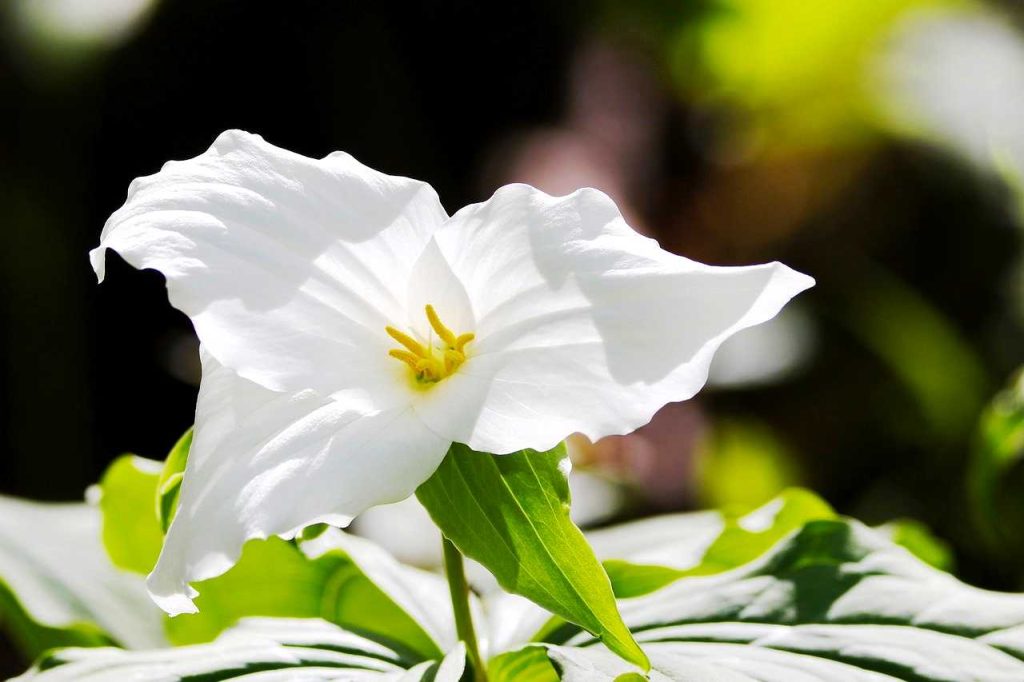
Also known as Trillium, Wake Robin is a captivating addition to any Zone 7 winter garden. With its three-petaled flowers that can appear in various shades, including white, pink, or deep red, Wake Robin offers not only beauty but also a sense of connection to the native flora of North America. This woodland perennial prefers shady, loamy areas and thrives in the understory of deciduous forests.
One of the most unique attributes of Wake Robin is its growth cycle. While the flowers bloom in early spring, the plant itself starts to emerge in winter, often through the last remnants of snow. This ability to grow and bloom in cooler temperatures makes it a symbol of resilience and adaptability. To cultivate Wake Robin, gardeners should ensure planting in rich, well-drained soil with plenty of organic material, as this plant thrives in nutrient-rich environments.
Furthermore, Wake Robin is often used in native landscaping, appealing to those looking to support local ecosystems. By attracting pollinators with its early blooms, this plant plays a crucial role in the lifecycles of numerous beneficial insects. For eco-conscious gardeners, including Wake Robin in their winter garden can be both aesthetically pleasing and environmentally responsible, contributing to biodiversity while showcasing one of the wonders of nature in the throes of winter.
Winter Aconite
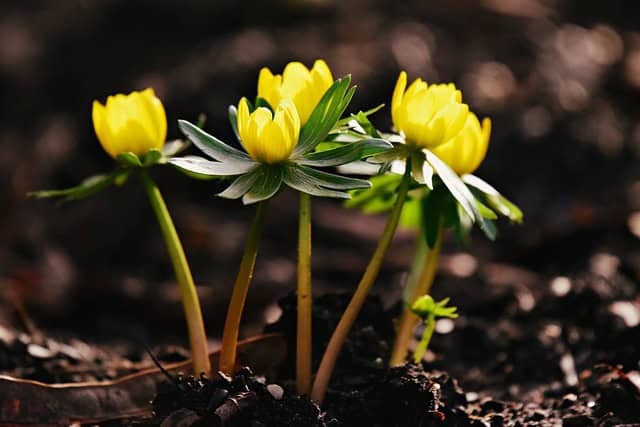
Winter Aconite (Eranthis hyemalis) is a delightful harbinger of spring, punctuating the drab winter months with bright yellow flowers that often emerge as early as January. This native of Europe is a true winter wonder, thriving in the cool temperatures of Zone 7. Its small, cup-shaped flowers are set against a backdrop of rich green, palmately lobed leaves, creating a striking contrast that brightens any dull landscape.
What makes Winter Aconite particularly enchanting is its ability to naturalize and spread, making it an excellent choice for planting in large drifts or mass plantings. Once established, this perennial can form a stunning, golden carpet that can transform shaded areas or drab borders into vibrant landscapes. They prefer moist, rich soil and can often be found gracing the edges of woodlands, where they thrive in partial to full shade.
Additionally, Winter Aconite is a relatively low-maintenance flower, requiring minimal care beyond ensuring it has adequate moisture, especially in dry spells. It’s important to note that while beautiful, all parts of the Aconite plant are toxic when ingested, so gardeners with pets or small children should take caution. However, as an aesthetically pleasing and early blooming addition to the garden, Winter Aconite is a wonderful highlight of Zone 7 winter flowers.
Persian Violet
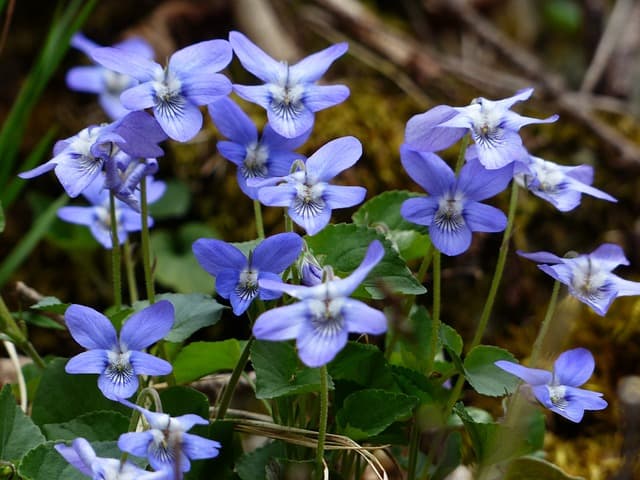
Persian Violet (Viola odora) adds a touch of elegance and fragrance to the cooler months, creating a delightful experience for both the eyes and the senses. These charming little flowers, known for their vivid purple or white petals and heart-shaped leaves, often bloom in late winter into early spring, offering early signs of life in the garden. As a perennial, Persian Violets can return year after year, enhancing the beauty of your winter landscape in Zone 7.
One of the standout features of Persian Violet is its intoxicating scent, reminiscent of sweet violets, making it perfect for planting near pathways or windows, where the fragrance can be enjoyed. They thrive in well-drained soil and prefer a spot with partial shade to protect them from the harshest winter sun. Clusters of these lovely violets not only add pleasing aesthetics but also attract pollinators like bees, which are crucial for early spring gardening.
For gardeners looking to enhance their winter garden, Persian Violets can be grown in containers, allowing for flexibility in placement and the opportunity to showcase their beauty on patios or balconies. Adding a splash of color and a dash of fragrance, these violets are a true winter gem, embodying the spirit of resilience that characterizes Zone 7 winter flowers.
Winter Iris

Winter Iris (Iris unguicularis), also known as the Algerian Iris, brings a unique flair to winter gardens, blooming during the colder months when many plants remain dormant. With its striking lavender to deep blue flowers emerging in midwinter, Winter Iris is versatile and can endure the frosty conditions typical of Zone 7. This hardy plant showcases long, narrow foliage that remains green throughout the year, providing visual interest even when not in bloom.
One appealing aspect of the Winter Iris is its adaptability to various soil types, thriving in well-draining, sandy soil or even clay, as long as there is good drainage. Planting these irises in sheltered areas can protect them from harsh winds, optimizing their growth. Their unique flowering schedule makes them standout specimens in any garden, as they can bloom from January into March, lifting spirits during the darkest months of the year.
Caring for Winter Iris is straightforward: water them adequately during dry spells to promote healthy growth, as they tend to be drought-tolerant once established. Additionally, their long-lasting blooms make for excellent cut flowers, bringing the beauty of winter into your home. The alluring charm of Winter Iris and its graceful nature make it an indispensable part of the Zone 7 winter flower collection.
Christmas Rose
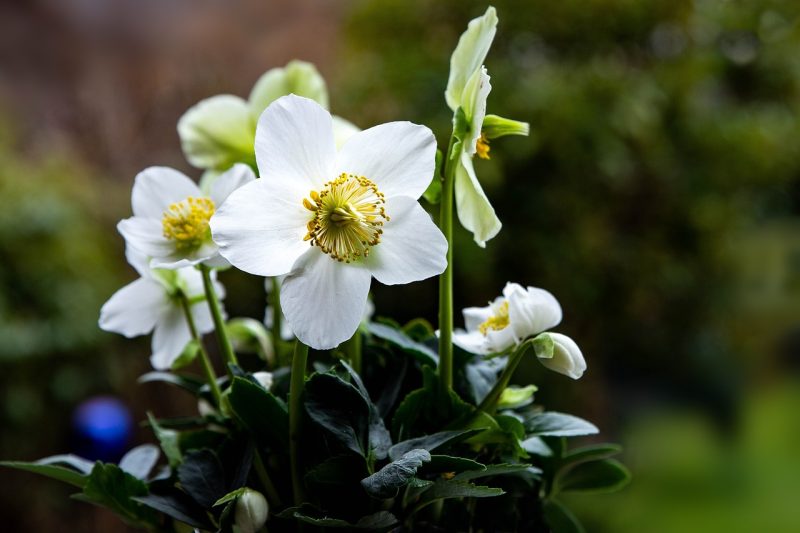
Christmas Rose (Helleborus niger) is a remarkable perennial that thrives in the cool climate of Zone 7, often blooming during the holiday season. Known for its enchanting, cup-shaped flowers that range from pure white to delicate pink, the Christmas Rose stands out as one of the most anticipated winter bloomers. This hardy plant not only brings festive cheer with its blooms but is also admired for its evergreen foliage, which remains lush year-round.
Gardening enthusiasts often appreciate the versatility of Christmas Rose, as it flourishes in shaded areas, making it perfect for woodland gardens or beneath tall trees. It is important to plant them in well-draining, rich soil to ensure healthy growth. Additionally, these flowers offer a stunning display as they age, transforming from an ethereal white to a deep, dusty pink—a process that adds nuance to winter gardens.
Another attractive feature of the Christmas Rose is its ability to attract pollinators, such as bees, even in the cooler months. The flowers are often one of the first sources of nectar available, contributing positively to the ecosystem. For gardeners eager to add winter charm to their landscapes, the Christmas Rose provides both beauty and ecological benefits, making it a quintessential choice for any Zone 7 garden.
Distylium

Distylium is a lesser-known but highly valuable evergreen shrub perfect for adding texture and interest to the winter garden. Like a hidden gem, this adaptable plant features unique, slender leaves that provide a lush green backdrop, creating a calming presence even in the colder months. With a range of cultivars available, Distylium can offer various growth forms and flower colors, typically blooming in late winter with small, inconspicuous red or yellow blooms that attract pollinators.
One of the standout characteristics of Distylium is its remarkable resilience to both drought and shade, making it an ideal choice for challenging garden conditions. It thrives in well-draining soil and can tolerate a variety of light conditions, from full sun to partial shade. This adaptability not only contributes to its hardiness but also makes it a versatile choice for mixed borders and foundation plantings.
In addition to its aesthetic appeal, Distylium’s evergreen nature provides year-round interest, ensuring that your garden remains vibrant even when other plants are dormant. Its ability to endure harsh weather conditions makes it a reliable addition for gardeners looking to maintain a lush landscape throughout winter. Incorporating Distylium into your Zone 7 winter garden will yield a strong, visually appealing foundation that complements seasonal blooms and brings life to your outdoor space.
Amaryllis

Amaryllis is a striking choice for gardeners looking to add drama and elegance to their winter displays. Often forced indoors for bright colors in the dreary months, this bulbous perennial lends itself beautifully to outdoor gardens as well, particularly in milder climates like Zone 7. Boasting large, showy blooms that can cover a variety of colors ranging from vivid reds and pinks to soft whites, Amaryllis creates stunning focal points in winter and spring gardens.
The beauty of Amaryllis lies not only in its flowers but also in the sheer size of its blooms, which can measure up to 8 inches in diameter. When planted outdoors, it’s best to do so in the spring, as these bulbs require warm soil temperatures to thrive. However, many gardeners enjoy the ritual of forcing Amaryllis bulbs indoors, providing a delectable dose of beauty as they bloom in winter. The result is a breathtaking contrast against the starkness of winter scenery.
Care for Amaryllis is relatively straightforward, as they prefer well-drained, nutrient-rich soil and adequate sunlight. In garden settings, they thrive in full sun to partial shade, making them flexible for a range of planting locations. Beyond their visual appeal, Amaryllis is also an excellent choice for pollinators, which can bolster the ecological performance of your garden in the winter months.
Lenten Rose
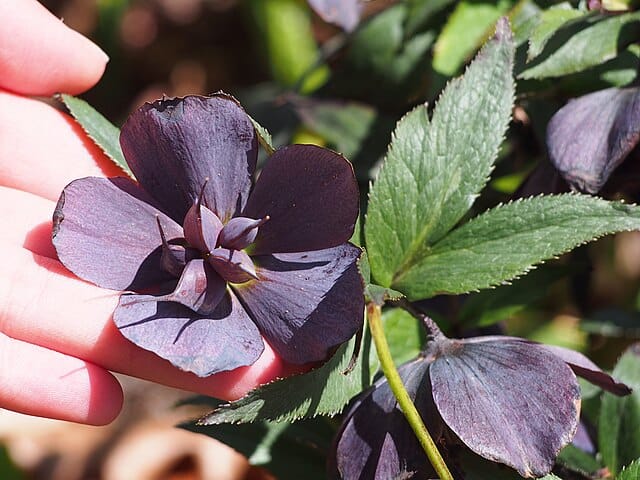
The Lenten Rose (Helleborus orientalis) is a standout among winter flowers, celebrated for its ethereal beauty and early blooms typically arriving around February, often in sync with Lent, which gives the plant its name. Unlike traditional roses, Lenten Rose features striking, cup-shaped flowers that come in an array of colors, including creamy whites, deep purples, and soft pinks. These mesmerizing blooms can last for weeks, making them a worthy centerpiece in any winter display.
One of the remarkable traits of Lenten Rose is its ability to thrive in shady locations, which makes it an excellent choice for gardens under the canopy of deciduous or evergreen trees. It prefers well-drained, rich soil and benefits greatly from organic matter, which encourages healthy growth. Beyond its visual appeal, Lenten Rose serves as an early source of nectar for pollinators, making it a fantastic addition to gardens aimed at supporting local wildlife.
The foliage of the Lenten Rose is also notable; its leathery, evergreen leaves remain vibrant throughout winter, contributing to the garden’s structure and appeal even when the flowers are not in bloom. As the winter temperatures fluctuate, the Lenten Rose stands resilient, offering beauty and life in the coldest months. By incorporating Lenten Rose into your Zone 7 winter garden, you will welcome a stunning display of color and a connection to nature at its finest.
Mahonia
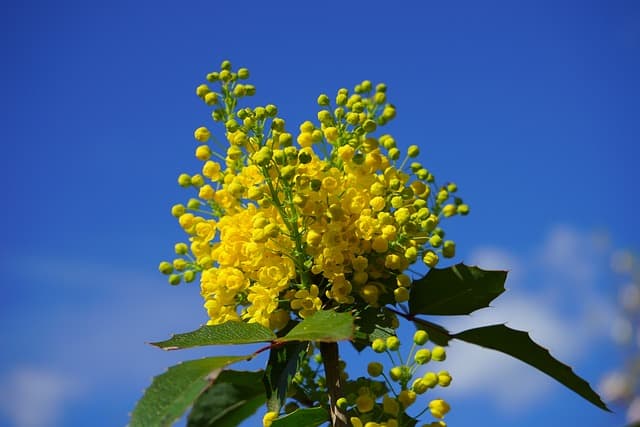
Mahonia, commonly known as Oregon Grape, is a versatile shrub that offers a touch of elegance to winter gardens in Zone 7. With its glossy, holly-like leaves and stunning clusters of yellow flowers that start blooming in late winter, Mahonia is a steadfast choice for adding winter interest. The vibrant yellow blooms, resembling small candles, not only provide color but also emit a delightful fragrance, attracting early birds and beneficial insects.
This sturdy shrub excels in shady or partially shaded areas, making it ideal for those hard-to-fill spots in your garden. Mahonia is drought-tolerant once established and can thrive in a diverse range of soils, as long as there is good drainage. Furthermore, its densely packed foliage creates a natural habitat for wildlife, providing shelter and food for various species throughout the winter months.
In addition to its beautiful flowers, the Mahonia plant produces dark blue berries in early summer that not only add visual interest but also attract birds and other wildlife. This dual purpose as both a flowering shrub and a source of sustenance for wildlife makes Mahonia an excellent choice for eco-friendly gardens. Its rich texture and timeless appeal become a focal point in winter landscapes, enhancing the overall charm of your Zone 7 garden.
Glory of the Snow
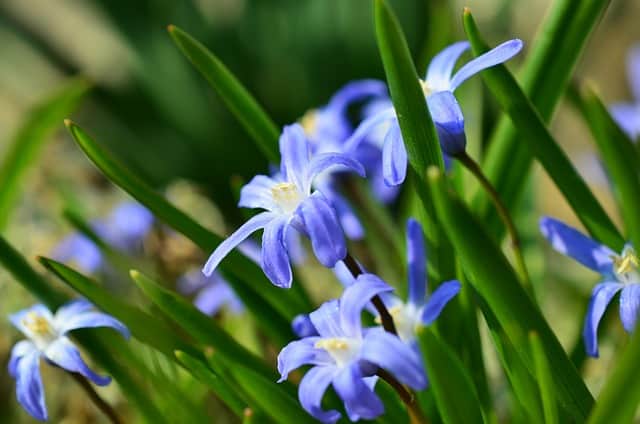
Glory of the Snow (Chionodoxa forbesii) is a small yet captivating bulb that emerges from the ground to brighten up winter gardens, typically blooming from late February to early March. These delicate flowers are known for their star-shaped, cobalt blue petals with white centers, evoking a sense of joy and renewal as they appear amid the remaining frost. The compact stature of Glory of the Snow makes them ideal for borders, rock gardens, or naturalized areas, where they can create a dazzling carpet of color.
One of the most appealing aspects of Glory of the Snow is its ability to bloom in challenging conditions, often breaking through the snow cover to make their presence known. They prefer well-drained soil and thrive in sunny or partially shaded spots, making them an adaptable option for various garden locations. Once established, they can multiply and naturalize, providing a delightful display year after year.
In addition to their beauty, Glory of the Snow is a favorite among pollinators, drawing bees and butterflies to the early blooms. Their resilience and charm make them particularly well-suited for gardens looking to support ecological health while maintaining aesthetic appeal. Including Glory of the Snow in your Zone 7 winter flower collection will ensure a stunning visual impact that heralds the arrival of spring, even during the coldest months.
Dutchman’s Breeches
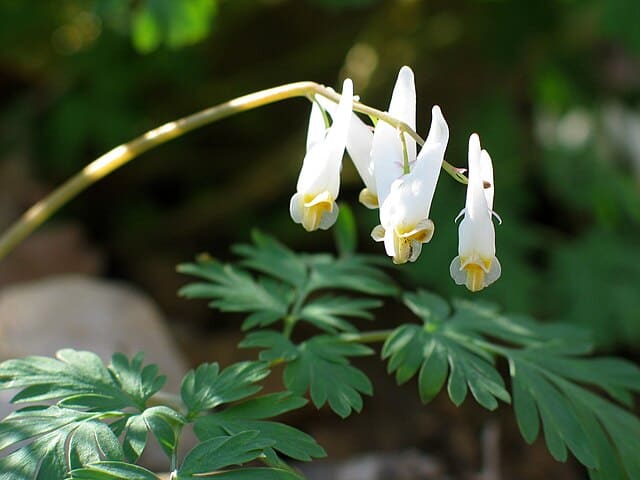
Dutchman’s Breeches (Dicentra cucullaria) is a delightful perennial that enchants gardeners with its whimsical, heart-shaped flowers, which bloom in early spring, usually around late March to early April. What sets Dutchman’s Breeches apart is their unique flower structure—each flower resembles a pair of white, pantaloons hanging from delicate green stems, creating a charming spectacle in any garden. This enchanting visual display is often one of the first signs of life that emerge after the winter snow has melted.
These plants thrive in dappled shade, making them perfect for woodland gardens or areas under the canopy of larger trees. Dutchman’s Breeches prefer rich, well-drained soil with plenty of organic matter to support their growth. They are also known for their historical significance; Native Americans used various parts of the plant for medicinal purposes, showcasing its value beyond aesthetics.
Another appealing aspect of Dutchman’s Breeches is their ability to naturalize over time, forming lovely colonies that contribute to a lush, vibrant woodland tapestry. By including them in your Zone 7 winter flower collection, you not only infuse your garden with eye-catching charm but also support a diverse ecosystem that encourages butterflies and other beneficial pollinators.
Daphne
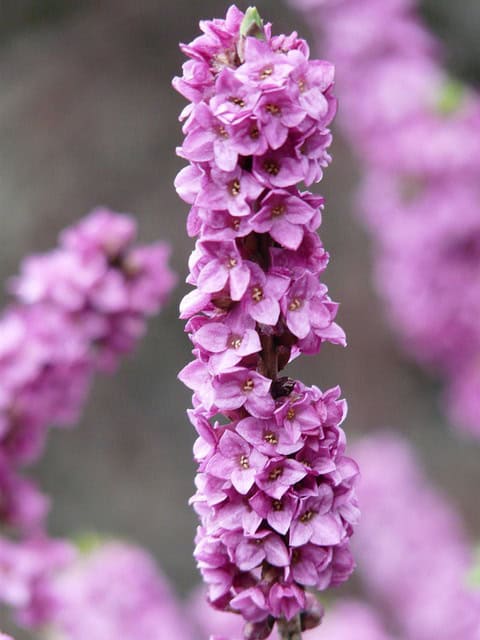
Daphne is a luxurious, evergreen shrub beloved for its fragrant pink or white flowers that burst into bloom in late winter or very early spring, typically around March. The scent of Daphne blossoms is heavenly, with sweet notes that can fill the air and draw gardeners and pollinators alike into its embrace. The small clusters of flowers contrast beautifully with the glossy, dark-green leaves, providing visual interest long before the spring flowering bulbs make their entrance.
Daphne thrives best in well-drained, slightly alkaline soil and appreciates a location with good air circulation. While it tolerates some shade, planting it in a spot where it receives partial sun will encourage more robust blooms. It’s important to give Daphne adequate protection from extreme cold and harsh winds, as this will support healthy foliage and flower development.
Interestingly, Daphnes are also remarkably low-maintenance once established. Despite their elegant appearance, they can tolerate dry spells, making them an attractive option for gardeners looking to create a beautiful landscape without excessive upkeep. Additionally, the allure of their fragrant blooms and evergreen presence makes Daphne an excellent choice for borders, foundation plantings, or as a specimen plant, enhancing the overall sophistication of any Zone 7 winter garden.
Daffodil
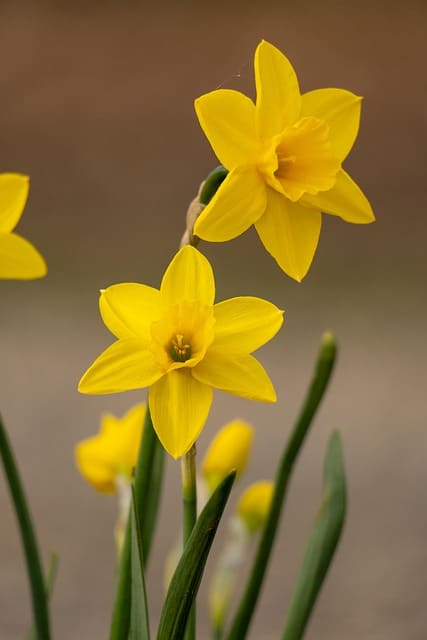
No winter garden in Zone 7 would be complete without the presence of Daffodils (Narcissus), heralded for their cheerful, trumpet-shaped blooms that dazzle during the transition from winter to spring. Typically breaking ground in late winter to early spring, Daffodils are known for their bright yellow and white flowers, which serve as a beacon of hope and renewal after the cold months. Their bright colors pierce through the soil, often swaying gently in early breezes, welcoming warmer days ahead.
These hardy bulbs are exceptionally easy to grow and can thrive in a variety of soil types, as long as there is good drainage. Daffodils prefer full sun or partial shade, making them versatile for a variety of garden settings. An added benefit is that they are relatively pest-resistant due to the presence of a toxic compound called lycorine, protecting them from common garden pests, which allows for vibrant blooms year after year.
Once planted, Daffodils will naturalize, returning each season with more vigor. They often multiply, spreading their cheer across gardens and landscapes. Daffodils can be used in borders, mass plantings, or even in containers, making them a versatile choice for any garden design. Their uplifting presence not only beautifies winter gardens but also draws early pollinators, contributing to the ecosystem’s health. By incorporating Daffodils into your Zone 7 winter flower collection, you can ensure a bright, promising start to the gardening year.
Rhododendron
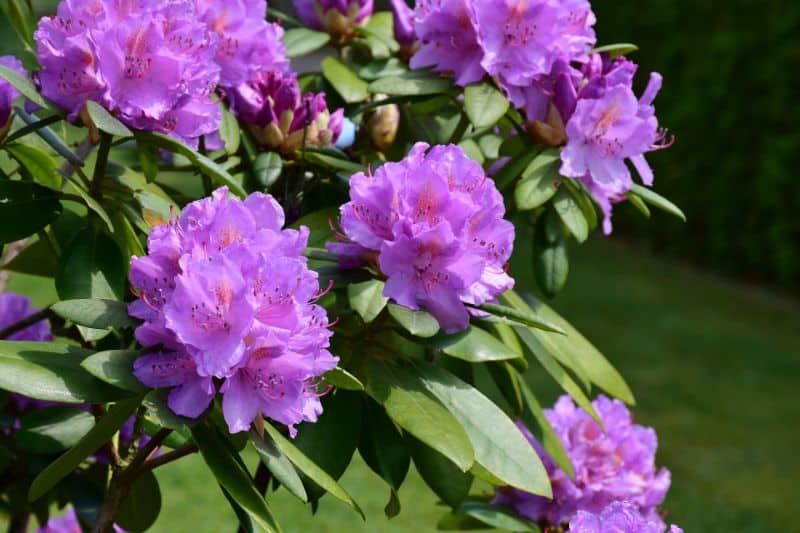
Rhododendron is one of the true jewels of winter gardens, known for its impressive blooms that can range from soft pastels to vibrant reds and purples, depending on the variety. These evergreen shrubs typically begin to flower in late winter or early spring, providing an eye-catching display that can elevate any garden’s visual appeal just as the days begin to lengthen.
One of the notable characteristics of Rhododendron is its lush foliage. The large, leathery leaves not only provide structure and texture in the garden but also serve as a beautiful backdrop for the bright flowers. These shrubs flourish in well-drained, acidic soil and prefer partial shade, making them ideal for woodland gardens or locations that receive filtered sunlight. Watering is crucial, particularly in the summer, as Rhododendron roots are shallow and can dry out quickly.
In addition to their visual charm, Rhododendrons are also beneficial for local wildlife. Their flowers attract pollinators, such as bees and butterflies, contributing to the ecosystem’s health. Moreover, the dense foliage offers shelter for songbirds during the winter months, making them a fantastic choice for bird-friendly gardens. For gardeners looking to create a rich, diverse landscape in Zone 7, Rhododendron is an excellent option that pairs beauty with ecological significance.
Abelia

Abelia is a versatile, semi-evergreen shrub that showcases delicate, tubular flowers that bloom from late summer and can last well into winter. Known for its aromatic, porcelain-like white or pale pink flowers, Abelia is particularly attractive to hummingbirds and butterflies, making it an excellent choice for a wildlife-friendly garden.
This resilient shrub thrives in a variety of soil types, though it does prefer well-drained conditions to prevent root rot. Abelia is often praised for its ability to adapt to diverse climates, tolerating drought once established while also flourishing in full sun to partial shade. The glossy, dark green leaves further enhance its appeal, turning to a deep bronze color in the cooler months, providing an additional layer of interest as winter progresses.
Beyond its ornamental quality, Abelia is low-maintenance and can be pruned to shape, allowing gardeners to customize their landscape easily. Use Abelia in borders, mass plantings, or as foundation shrubs to create visual interest throughout the entire winter season. Its enduring blooms, aromatic flowers, and attractive foliage make it a cherished addition to any Zone 7 winter flower collection, drawing both beauty and biodiversity.
Camellia
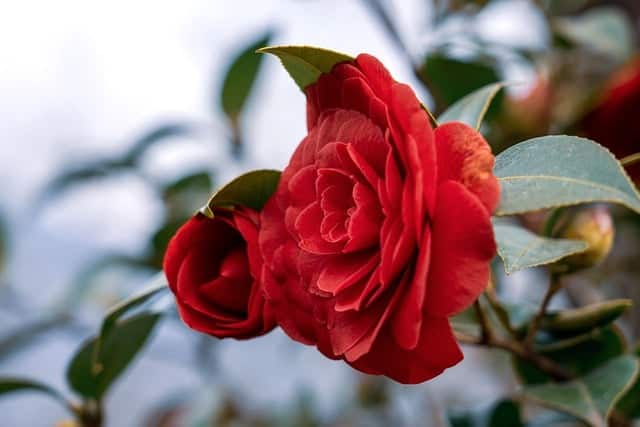
Camellia, particularly the varieties that bloom in winter, such as Camellia japonica, truly stand out as one of the most elegant choices for a winter garden in Zone 7. These evergreen shrubs feature glossy, dark green leaves that remain vibrant throughout the year, while their stunning flowers, which can be pink, red, or white, create a striking display against the stark winter backdrop. Blooming typically from late winter into early spring, Camellia flowers can last several weeks, providing a delightful anticipation of the spring season.
Camellias thrive in well-drained, acidic soils and prefer locations that offer partial shade, which helps to protect the delicate flowers from harsh winter storms and intense sunlight. Regular watering is essential to encourage strong growth and lush blooms, especially during dry spells in early spring. Additionally, applying a layer of mulch can help retain moisture and provide a consistent temperature for the roots.
Another fascinating aspect of Camellias is that they can be used in various garden styles, from formal hedges to casual cottage gardens, owing to their versatile growth habit. These beautiful shrubs also provide vital nourishment to early pollinators as they emerge from winter dormancy. By incorporating Camellia into your Zone 7 winter garden, you can enjoy not only their breathtaking flowers but also the soothing presence of lush foliage and the promise of spring all winter long.
Junipers

Junipers (Juniperus spp.) are evergreen conifers that hold a special place in winter gardens due to their diverse forms, colors, and resilience. These versatile shrubs can easily adapt to various soil conditions and environmental settings, from sprawling ground covers to upright hedges. Many varieties showcase stunning blue-green foliage that can turn striking shades of purple or bronze in the winter cold, creating a captivating contrast against the white snow.
One of the defining features of Junipers is their ornamental berries, typically ranging in color from green to blue, depending on the species. These berries not only provide visual interest but also attract birds seeking food in the colder months. Furthermore, Junipers are drought-resistant once established, making them a practical selection for gardeners looking to minimize maintenance in their landscapes.
As ground covers, Junipers can help prevent soil erosion while creating visually appealing mats of greenery that blanket the garden. For those interested in creating layered landscapes, taller varieties of Junipers can serve as effective privacy screens or windbreaks, adding both structure and function to winter gardens in Zone 7. Their adaptability and strength make Junipers a standout choice for a winter garden that remains lush and engaging even in the coldest months.
Pansies

Pansies (Viola tricolor var. hortensis) are delightful winter flowers that bring a burst of color to gloomy winter gardens. Known for their vibrant hues and unique facial markings, Pansies are one of the few flowers capable of blooming during the cold months, often starting in late fall and continuing through to spring. Their breadth of color options, from deep purples to golden yellows, allows for creative combinations that brighten up any landscape.
These hardy annuals can survive freezing temperatures, making them perfect for fall and winter planting. Pansies prefer well-drained soil and thrive best in cooler climates, where they remain vibrant rather than wilting in the heat. Planning for Pansies means iterating on design; planting them in containers or borders not only showcases their colorful presence but also allows for flexibility in garden arrangements.
In addition to their aesthetic appeal, Pansies are edible flowers, often used in salads and garnishes, adding a whimsical flair to culinary dishes. They are also known to attract beneficial insects like pollinators, enhancing the ecological balance of your garden. By incorporating Pansies into your Zone 7 winter garden, you provide not only a cheerful touch of color but also enrich the landscape with natural diversity.
Pieris
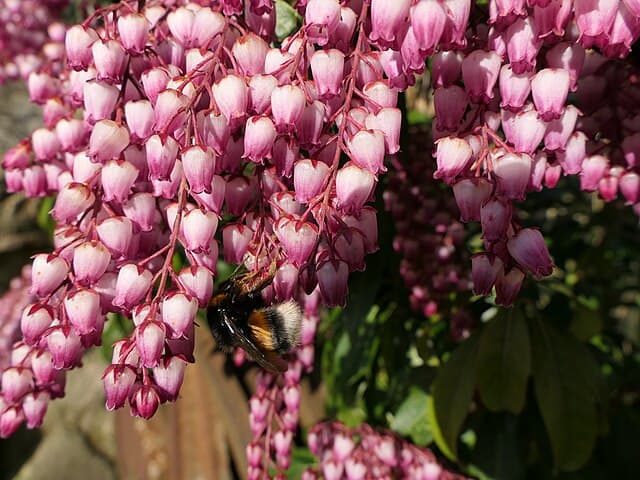
Pieris, commonly known as Lily-of-the-Valley shrub (Pieris japonica), is a remarkable evergreen shrub that captivates gardeners with its stunning, bell-shaped flower clusters and glossy foliage. Blooming in late winter and early spring, these delicate white or pink flowers hang gracefully from arching branches, offering a gentle and serene visual in the winter landscape. The blooms often appear just as the leaves begin to emerge, creating a layered effect that adds depth to the garden.
Pieris thrives in acidic, well-drained soils and prefers locations with partial shade to full sun, although it requires protection from harsh afternoon sun. One of its distinct characteristics is the vibrant red color that the new foliage displays in early spring, transitioning to a rich green as it matures. This seasonal variability adds a dynamic quality to the winter garden, keeping it fresh and engaging.
Another benefit of Pieris is its ability to attract pollinators to the garden during a time when other sources of nectar are scarce. The fragrant flowers are particularly attractive to bees, adding to the diversity of wildlife visiting your outdoor space. With its elegant appearance, adaptability, and encouraging connection to local ecosystems, Pieris makes an exceptional choice for those looking to create a refined and enchanting winter garden in Zone 7.
Primrose
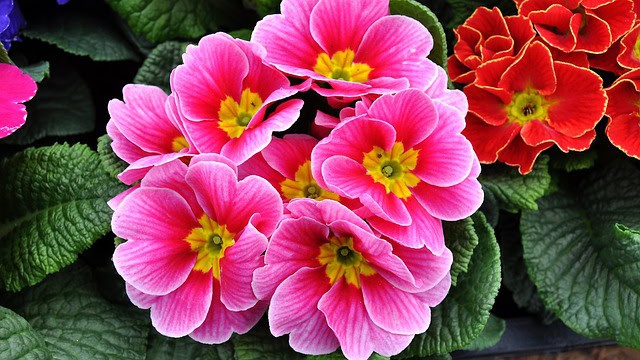
Primrose (Primula spp.) is among the earliest bloomers when it comes to winter flowers, often emerging in late winter and heralding the arrival of spring. These hardy perennials boast a variety of colorful blossoms, ranging from vibrant yellows and pinks to deep blues and purples, which can instantly uplift a garden’s spirit during the cold months. Primroses thrive in well-drained, moisture-retentive soil, and they prefer locations that offer some shade—making them ideal for planting beneath deciduous trees or in woodland gardens.
What makes Primrose particularly compelling is not just its look but also its ability to flourish in cold temperatures. They are frost-tolerant and can even bloom in the midst of light snowfall, adding a delicate touch to a wintry landscape. Additionally, Primroses are beloved for their soothing fragrance, which can attract early pollinators emerging from hibernation.
These charming flowers can be planted in clusters for a more dramatic effect, creating a captivating carpet of color against the stark winter backdrop. Gardeners can mix different varieties to extend the bloom time and create a visual feast. By integrating Primrose into your Zone 7 winter garden, you can enjoy an enchanting display that offers both beauty and a touch of nostalgia as they are often associated with early spring’s return.
Scilla
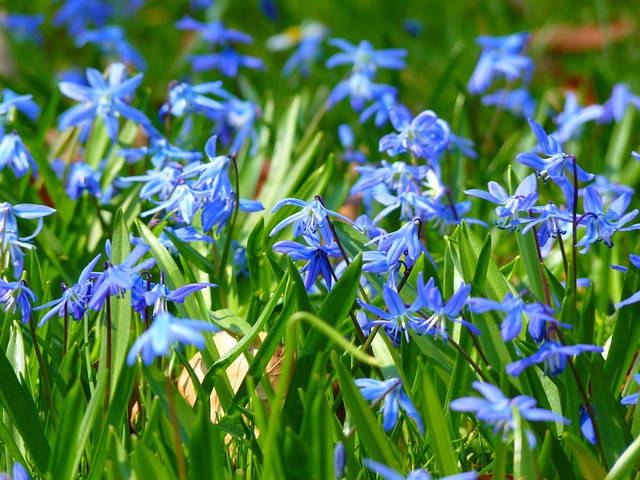
Scilla (Scilla siberica), also known as Siberian Squill, is another delightful addition to any winter garden in Zone 7. This hardy bulb prefers well-draining soil and basks in full sun to partial shade, making it versatile for various garden settings. One of the most charming aspects of Scilla is its stunning blue flowers that often emerge as early as late February, providing a delightful burst of color when most other plants are still dormant.
With their star-shaped blossoms, Scilla creates a sea of blue that can blanket garden beds, under trees, or in naturalized areas. These bulbs are resilient plants that can handle fluctuations in temperature, making them ideal for the unpredictable winter climate in Zone 7. Additionally, Scilla is a low-maintenance plant that does not require much attention once established, allowing gardeners to enjoy its beauty without significant upkeep.
Scilla not only brightens winter gardens but also attracts honeybees and other early pollinators looking for sustenance during the cold months. Planting Scilla in groups will enhance their visual impact and create a stunning display that signals the end of winter and sets the stage for spring. Their early blooms act as a reminder of nature’s resilience, making them a cherished choice for anyone looking to create a vibrant winter landscape.
Winter Heath

Winter Heath (Erica carnea) is an enchanting evergreen shrub that brings a unique charm to winter gardens in Zone 7. Known for its bell-shaped flowers that bloom from late winter into spring, Winter Heath showcases an array of colors, including pinks, purples, and whites, adding a delightful pop of color to the winter landscape. This hardy plant is particularly ornamental, with its needle-like foliage providing year-round interest.
Winter Heath thrives in well-drained acidic soils and prefers a sunny location to flourish. Once established, it is relatively drought-tolerant, making it a practical choice for low-maintenance gardeners. The blooms of Winter Heath are particularly appealing; they not only brighten up the garden but also provide essential nectar for early-season pollinators. This makes it an important component of a biodiverse garden ecosystem.
This plant can be used effectively in various design schemes, such as rock gardens, ground cover, or mixed borders, providing texture and variety throughout the winter. Its ability to thrive in colder weather and provide late winter blooms makes Winter Heath a valuable addition to any Zone 7 garden. By planting Winter Heath, gardeners can create a stunning focal point that beautifully encapsulates the magic of winter, inviting pleasant sights and sounds into their outdoor spaces.
Winter Jasmine
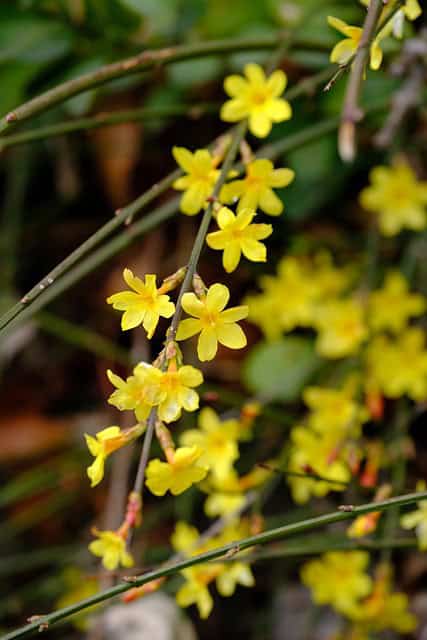
Winter Jasmine (Jasminum nudiflorum) is a delightful, deciduous shrub that brings a splash of sunny yellow to the winter landscape. Unlike traditional jasmine species that bloom in warmer months, Winter Jasmine surprises gardeners by flowering from late winter to early spring, often appearing as early as January. This delightful shrub is characterized by its slender, arching stems that produce delicate, trumpet-shaped flowers, which create a cheerful contrast against the typically muted winter surroundings.
This hardy plant thrives in well-drained soil and can adapt to both full sun and partial shade, making it an excellent choice for various garden settings. Its ability to tolerate a range of soil types adds to its appeal for gardeners looking to diversify their winter bloomers. While relatively low-maintenance, Winter Jasmine benefits from occasional pruning to encourage new growth and enhance flowering.
One of the most remarkable aspects of Winter Jasmine is its versatility. It can be trained to grow as a sprawling ground cover, draped over walls, or trained to climb trellises, allowing for creative landscaping possibilities. Additionally, its flowers provide early-season nectar for pollinators, making it beneficial for the local ecosystem. Incorporating Winter Jasmine into your Zone 7 garden ensures that the winter months are punctuated with flashes of color, symbolizing the approach of spring.
Witch Hazel
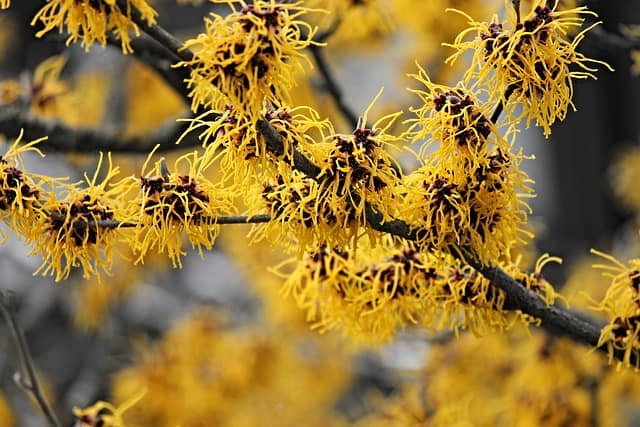
Witch Hazel (Hamamelis spp.) is a captivating deciduous shrub or small tree that stands out during winter with its unique, fragrant blooms. As one of the first plants to flower in the late winter months, Witch Hazel bursts forth with clusters of ribbon-like petals in vibrant shades of yellow, orange, and red. These striking flowers usually begin to open as early as January and can continue blooming into March or April, making them a true herald of spring.
Witch Hazel thrives in rich, well-drained soil and prefers partial shade to full sun exposure, although its adaptable nature allows it to flourish in various garden conditions. This plant is renowned not only for its beauty but also for its remarkable ecological benefits. The flowers attract a range of pollinators, including bees, that are emerging from hibernation, thus playing a vital role in supporting the health of the local ecosystem.
In addition to its stunning blooms, Witch Hazel showcases attractive fall foliage, which typically turns yellow or red, providing seasonal interest beyond the winter months. Its unique growth habit makes it suitable for use as a specimen plant, in borders, or as part of a larger naturalistic garden design. By adding Witch Hazel to your Zone 7 winter garden, you not only gain a breathtaking focal point but also help foster biodiversity, making it a wonderful investment for any plant lover.


